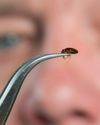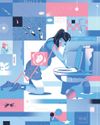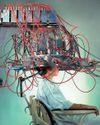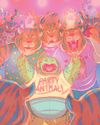
Every morning, as I prepare his food, our black-and-white lurcher, Ozzy, looks up at me with the warmest of eyes. He will give me the eyebrows too. The cutest of smiles. He will cock his head in expectation of food, and seems to know that I will give it to him, devoted as I am. “Does he really love me?” I wonder, as he waits patiently for his tripe with his tail wagging furiously. Because sometimes I have the vaguest feeling I am being hustled. Like I am one of Pavlov’s dogs and he is Pavlov, conditioning me with cuddles and baby-faced eyes to do nice things for him. Is this love or something else? Can dogs ever really love their humans like we love them? It turns out that questions like these have a rich scientific history, with an exciting conclusion that could forever change our relationship with dogs. The story of dogs and emotions begins in the Victorian era when the question sparked one of the first culture wars in history. It involved banners, placards and leaflets. It had burning effigies and vandalised statues, angry marches and speeches in packed-out town halls. At one point, hundreds almost fought in the street. They were ready to fight about whether emotions like love were uniquely human or common to many animals, particularly social mammals such as dogs.
Diese Geschichte stammt aus der July/August 2022-Ausgabe von Very Interesting.
Starten Sie Ihre 7-tägige kostenlose Testversion von Magzter GOLD, um auf Tausende kuratierte Premium-Storys sowie über 8.000 Zeitschriften und Zeitungen zuzugreifen.
Bereits Abonnent ? Anmelden
Diese Geschichte stammt aus der July/August 2022-Ausgabe von Very Interesting.
Starten Sie Ihre 7-tägige kostenlose Testversion von Magzter GOLD, um auf Tausende kuratierte Premium-Storys sowie über 8.000 Zeitschriften und Zeitungen zuzugreifen.
Bereits Abonnent? Anmelden

TAKE IT SLOW
Slow running is a fitness trend with some hard and fast science behind it

Physics, AI and music share a common thread. You just have to know where to look
Studying science can lead you in many directions and open doors to unexpected possibilities along the way

BED BUGS VS THE WORLD
When bloodthirsty bed bugs made headlines for infesting Paris Fashion Week in 2023, it shone a spotlight on a problem that's been making experts itch for decades: the arms race going on between bed bugs and humans

Kids are the key to understanding obesity. But we need more of their genes...
We can unravel the role that bodyweight plays in disease, but we need a bigger, more diverse, sample of genetic material to do so

COVID inquiry: What did we learn and what can we do better in future pandemics?
Masks, social distancing, lockdowns... how effective was the UK's response to the COVID-19 pandemic?

One hormone could be the key that unlocks a cure for morning sickness
The nausea and vomiting that, in extreme cases, can endanger mothers and babies might soon be just a memory

THE WORLD'S WEIRDEST CREATURES
Under the sea and upon the land, some animals look - to us - pretty strange...

WHEN MIND AND MACHINE COLLIDE
First, Elon Musk wanted to make electric cars ubiquitous, then he wanted to make space exploration a private enterprise. Now, with Neuralink, his newest venture, Musk hopes to merge humans and artificial intelligence. Turns out, it might not be such a crazy idea...

COME OUT OF YOUR SHELL
Social anxiety is more than just being shy. It's a phobia born out of our evolutionary past. But that raises a puzzling question: why do so many of us fear human interaction when we're supposed to be the most sociable species on the planet?

SPACE ODDITIES
Take a tour of the weirdest spots in the universe, where the 'normal' rules don't apply. Places that squeeze time, blow bubbles and even rain glass... sideways